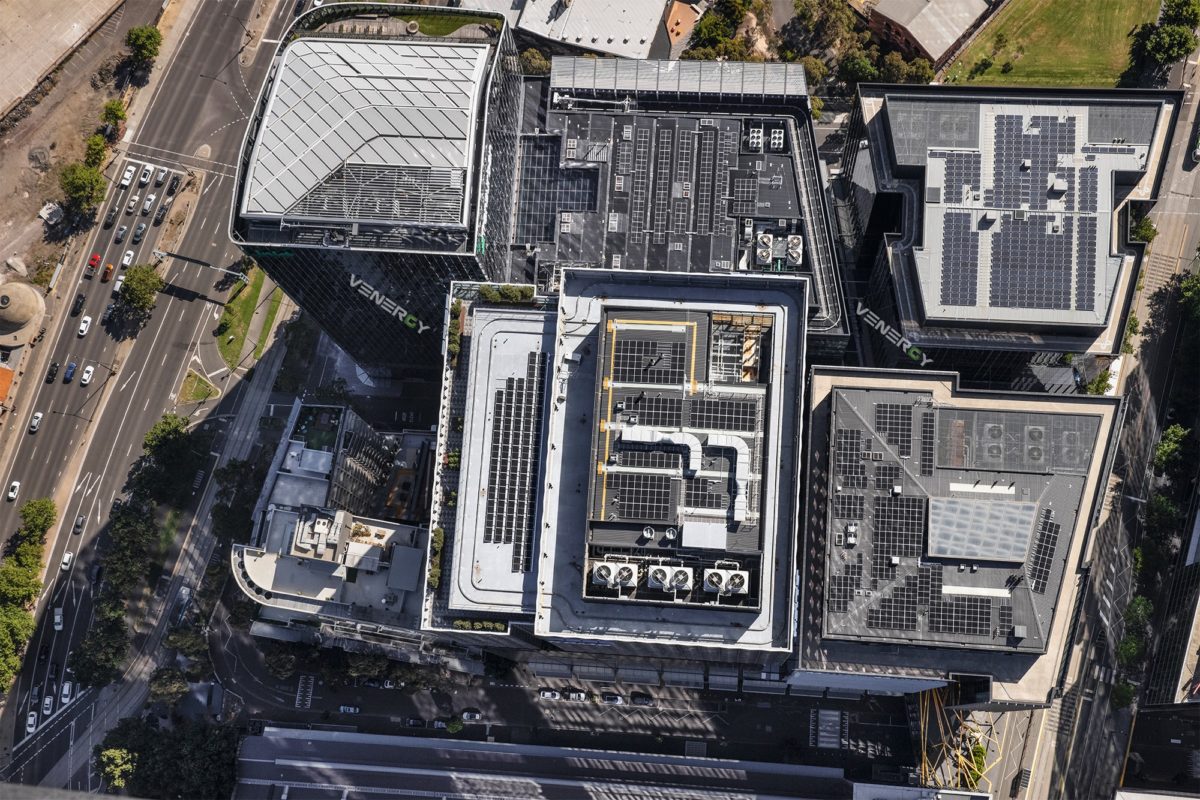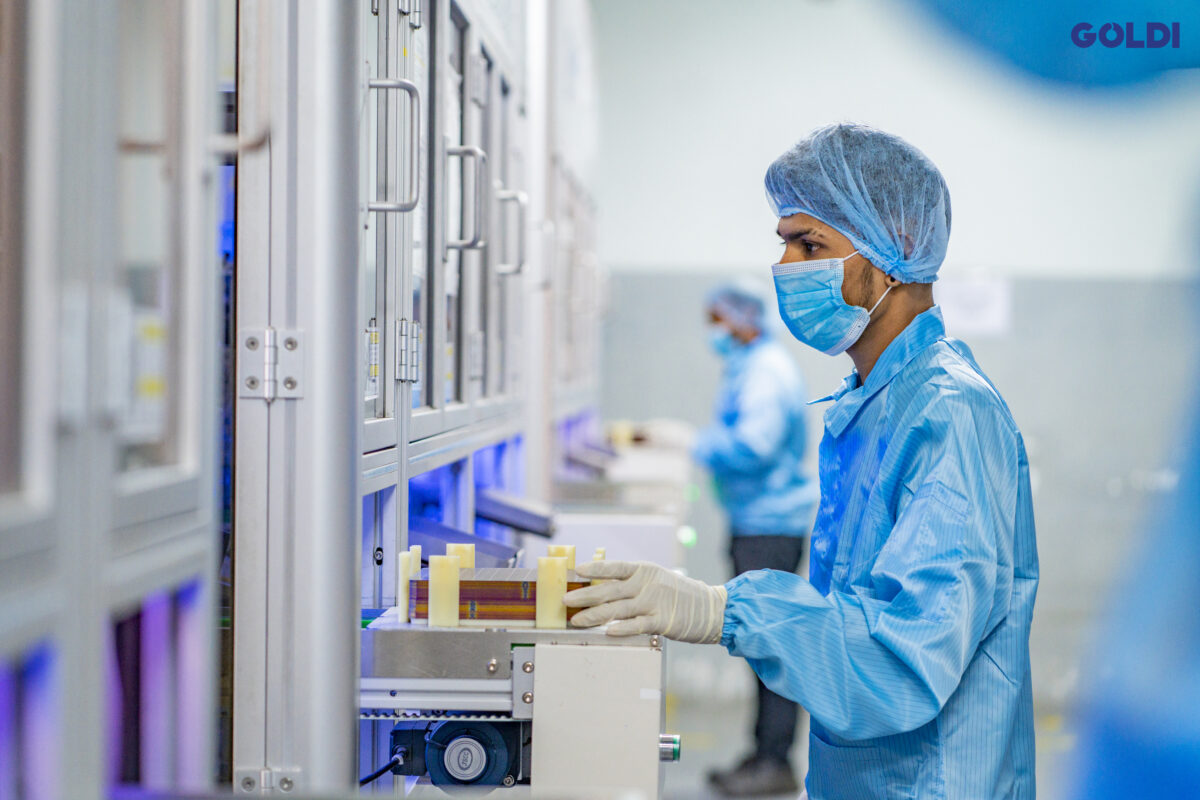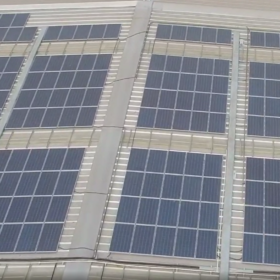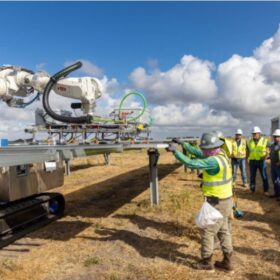From pv magazine 05/2022
The heart of downtown Melbourne, Australia, is known for many things: little “Instagrammable” lanes of graffiti, trendy cafes, trams, museums, and of course, its cluster of skyscrapers shooting up out of nowhere like the Emerald City of Oz. But what those walking the streets of downtown Melbourne can’t see 145 meters above their heads is that there are 500 Trina Solar modules operating as a 223 kW system atop Towers One, Two and Four of Walker Corp.’s Collins Square Tower site.
Putting solar panels on rooftops is hardly newsworthy; indeed, Australia is the world leader of solar rooftop installation. But putting solar atop skyscrapers is not so common, partly because the generation profile has not been worthwhile. After all, the point of tall buildings is that the roof represents only a tiny fraction of the structure’s overall square footage.
However, thanks to recent advances in solar panel energy density, that profile has changed. Recognizing this, Walker Corp., one of Australia’s largest private development companies, teamed up with Venergy Australia to deliver the SolarEdge-optimized solar system to its Collins Square Tower development.
“With the advances in solar technology, energy-dense panels now available exceed 450 W per panel, enabling significant and meaningful renewable projects in CBD locations that couldn’t otherwise be achieved on the constrained rooftop,” said Venergy Australia CEO Matthew Wilkins.
Venergy integrated the 223 kW solar system with the building’s regenerative lifts and its trigeneration of 600 kW gas turbines across five commercial towers, bringing the site’s total generating capacity to 2 MW.
Cameron Forbes, engineering and sustainability manager for Walker Corp., told pv magazine that the company strives to ensure its towers are equipped with “advanced solar technology” that can be fully integrated with “our existing energy monitoring and management systems, enabling our team to constantly track the panels’ performance.”
Two to tango
The Collins Square Tower solar setup is not the only sky-scraping solar array in town. In fact, Cbus Property announced in November 2021 that it’s planning to clad a AUD 1 billion ($720.5 million) commercial office tower in Melbourne’s central business district with a “solar skin” that is capable of generating 20% of the project’s base building electricity requirements.
Looking at these two projects, we see two differing ways to integrate solar into high-rise buildings: rooftop solar and building-integrated PV (BIPV). But by combining the two, we may be looking at the future of energy-integrated construction in vertical cities – namely, the two-punch generation combo of integrating both energy-dense rooftop panels and BIPV.
That combo is precisely what the Monash University-based ARC Centre of Excellence in Exciton Science found, in collaboration with the University of Lisbon. Researchers 3D modeled the viability and impact of window-integrated photovoltaics alongside other solar technologies at a city scale. Published in the journal Solar Energy, the study found that buildings in Melbourne could provide 74% of their own electricity needs if solar technology was fully integrated into roofs, walls and windows. Rooftop solar would constitute 88% of this supply, with wall-integrated and window-integrated solar delivering 8% and 4%, respectively.
The research team, including study co-author Professor Jacek Jasieniak, looked at a 37.4 square kilometers (sqm) of central Melbourne, of which 35.1 sqm was residential and commercial buildings as of 2019. They then determined the annual solar irradiation on Melbourne’s building surfaces to identify suitable areas for PV, taking into account cost factors, technical limitations, shading and shadows. And at city scale – including warehouse-sized rooftops in city surrounds such as ports and stadiums, like the famous Melbourne Cricket Ground – the rooftop capacity potential is staggering.
“Our goal was to showcase that actually there is huge potential (for urban PV, particularly rooftop), it’s just enormous,” said Jasieniak. “But people don’t think about it because people tend to think at the scale of a building rather than the scale of a city.”
“As technology evolves, what we will find is that the incremental costs to add the PV components into the buildings is going to make the value proposition for integration very strong,” continued Jasieniak. “Our driver for this study was to understand the opportunity for window-integrated solar cells, and what came out of the study was that actually, for most buildings, rooftop is very attractive. It’s the low-hanging fruit out there.”
But Jasieniak notes that rooftop primacy will remain the case as long as walls and windows (BIPV) still require a technology revolution. Compared to rooftop, the cost of a solar window is “an order of magnitude higher than what you would pay for a solar cell on a roof.”
However, the study co-author noted, “if your building is costing you, say, AUD 1 billion, and you’re spending AUD 40 million on solar cells which over the course of their lifetime will bring back electricity, that is the important part to consider. The upfront cost is not the driving force, it should always be the levelized cost of electricity. It’s always a question of payback period, it won’t be seven years, but does it really need to be in a commercial building that will last at least 40 years? I don’t think so.”
Jim Stewart, associate director at Fender Katsalidis – the Australian architectural firm behind the world’s second-tallest building, Kuala Lumpur’s 678.9-meter Merdeka 118 (p. 50), topped with a 140 kW solar array for its Park Hyatt Kuala Lumpur hotel – told pv magazine that clients are encouraged to consider PV solutions, as “most buildings over 180 meters tall are not demolished within 50 years.”
“Rooftop solar arrays have become common place in skyscraper design and development,” continued Stewart. “And, in the Australian context, their economic viability has been proven and accepted. Space is always limited however, so ever-increasing densities allow us to push further in terms of design flexibility and system capacity. In the context of high-rise development, PV is a mature and affordable technology with the ability to power building services and reduce peak loads on the grid; a ‘no-brainer’ indeed.”
Key challenges
Along with the sheer potential of PV in vertical cities come challenges. Firstly, most PV installations would be brownfield retrofits on existing rooftops, which can be problematic, as tall buildings often have other infrastructure already.
Another challenge is that tall buildings tend to be rented, making it difficult to clarify whose responsibility and direct benefit PV would be. “But there’s a value proposition in that,” argued Jasieniak. “There has been a business-sentiment shift – companies are now demanding 10-star building requirements, and at that level you need onsite energy generation.”
But builders are also required to change and support PV integration. “A lot of these building companies just do what they’ve done for a long time,” argued Jasieniak. “Innovation to building practices is needed to support construction at scale.”
Nevertheless, Jasieniak sees a future where tall buildings boast rooftop PV, with BIPV further down the line, and possibly net-zero carbon buildings. Before then, he says there are tough questions in terms of policy, and value shifts in both individual companies and for developers and builders in terms of PV integration. “I think there is a market segmentation opportunity there, too.”
This content is protected by copyright and may not be reused. If you want to cooperate with us and would like to reuse some of our content, please contact: editors@pv-magazine.com.









By submitting this form you agree to pv magazine using your data for the purposes of publishing your comment.
Your personal data will only be disclosed or otherwise transmitted to third parties for the purposes of spam filtering or if this is necessary for technical maintenance of the website. Any other transfer to third parties will not take place unless this is justified on the basis of applicable data protection regulations or if pv magazine is legally obliged to do so.
You may revoke this consent at any time with effect for the future, in which case your personal data will be deleted immediately. Otherwise, your data will be deleted if pv magazine has processed your request or the purpose of data storage is fulfilled.
Further information on data privacy can be found in our Data Protection Policy.